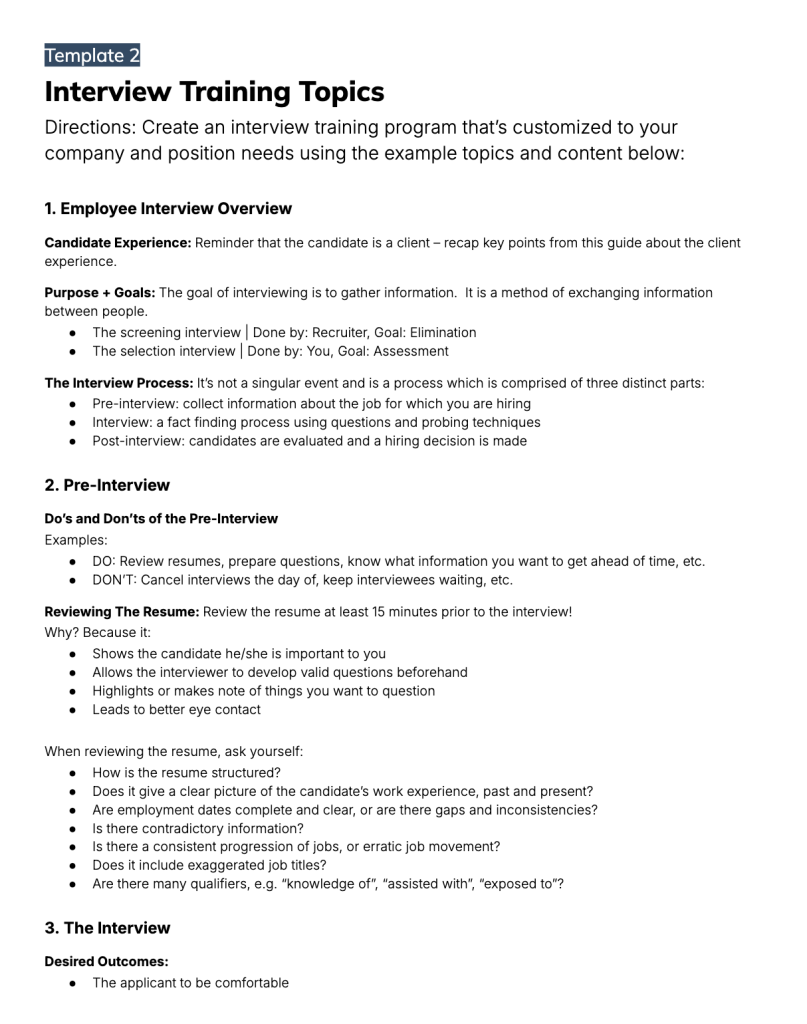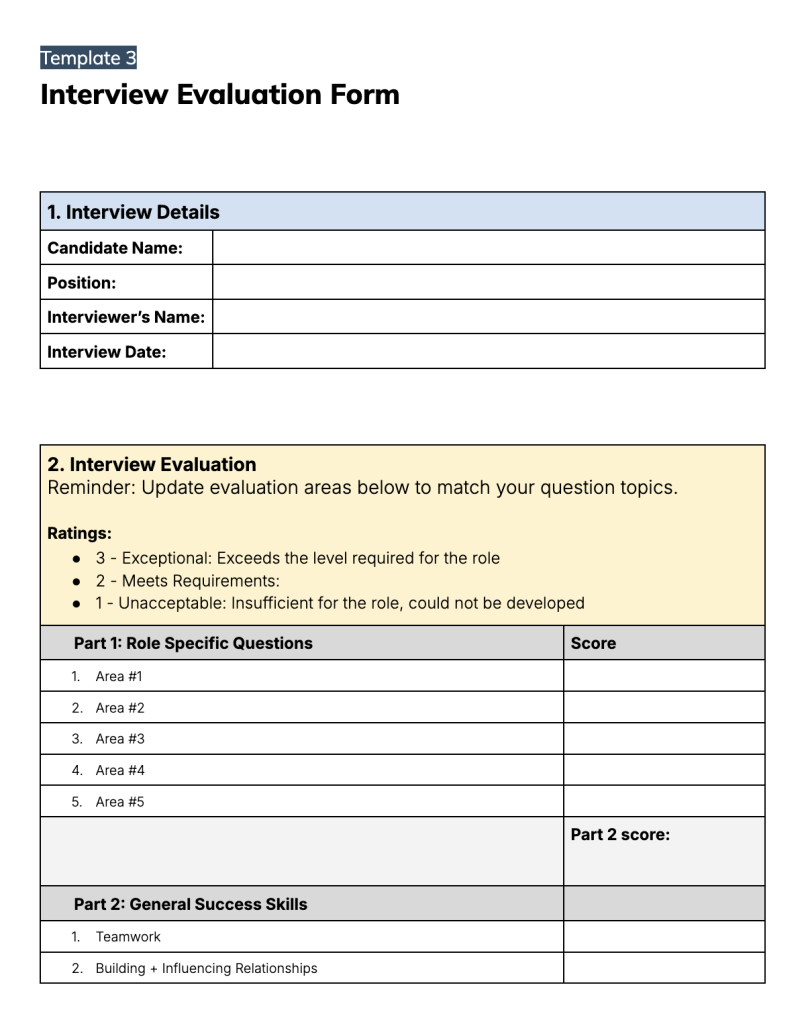💬 The Candidate Experience: Why It Matters
Setting the right tone for candidate experience is essential for engaging top talent. A positive experience:
- Attracts the right talent: Candidates talk, especially in marketing communities. A smooth, professional process will enhance your employer brand and encourage high-quality candidates to apply.
- Improves retention: When candidates feel valued and respected, they’re more likely to accept an offer and remain loyal employees.
- Protects your brand: A poor candidate experience can negatively impact your company’s reputation. Negative Glassdoor reviews and word-of-mouth can deter top talent from considering future roles.
- Enhances internal culture: Treating candidates well reflects a culture of respect and professionalism, which extends to how employees are treated.
Step 1: Create/post the job description + sort through applications.
Step 2: Coordinate interviews with candidates and internal interviewers.
Step 3: Ensure your internal interviewers are well prepared and aligned.
🏁 How to Establish a Seamless Interview Experience
STEP 1
Create/post the job description + sort through applications.
💥 Action Items + ✅ Templates
- #1: Create an outcome-based job description (shown right.)

- #2: Post your job description.
- #3: Sort through applications to find the best possible talent.
💬 Tips: Screening Resumes + Applications in an Effective, Organized Manner
- Leverage an applicant tracking system (ATS) to automate and streamline your application sorting process. These systems allow you to use keyword tagging for skills, experiences, and education to quickly sort for top matches.
- Look for narrative indicators of success. Focus beyond keywords and look for patterns in a candidate’s resume that show growth, leadership, adaptability, and achievements, which can indicate how they might contribute to your team. Preliminary screening tools – like questionnaires – can be a great way to determine fit early on.
- Track candidate progress using your favorite PM tool. Every marketer loves a good project tracking system. Use your favorite tools like Trello, Asana, or ATS features for tracking applicant status (e.g., review pending, first interview completed, second-round invite sent). Use shared dashboards to keep everyone on the same page.
- Communicate updates in a timely manner. Develop automated responses/templates to keep candidates updated. Avoid long silences, which could lead top talent to accept other offers.
STEP 2
Coordinate interviews with candidates + internal interviewers.
💥 Action Item
- #4: Establish a system for coordinating interviews with candidates and interviewers that’s communicative and easy to take action on.
💬 Tips: Effective Interview Coordination
- Centralized scheduling: Tools like Calendly or Doodle can help coordinate interviews without endless email back-and-forth. Make sure your scheduling process is candidate-friendly.
- Transparent candidate communication: When scheduling, provide clarity on how many interview rounds they can expect, the expected timeline, and next steps.
- Interviewer Communications – content to include:
- Candidate Information and Resumes: Include a concise brief for each interviewer with the candidate’s resume, the role they’re applying for, and relevant notes on why they were selected for an interview.
- Position Details: Outline key qualifications, the job description, and share insights into the role’s external positioning. This could include details on how the position fits within broader company initiatives.
- Interview Panel Information: Share who the interviewers are, their roles, and any specific aspects of the job they will be focusing on during the interview (e.g., one interviewer focusing on technical skills, another on culture fit).
STEP 3
Ensure your internal interviewers are well prepared and aligned.
💥 Action Items + ✅ Templates
- #5: Establish a formal interviewer training program.
Customize the program to your organization’s needs by leveraging the Interview Training Topics template here.

- #6: Create interview questions custom to your organization + role needs.
Customize the questions by leveraging the Interview Questions template here.

- #7: Create an interview evaluation form.
Customize the form by leveraging the Interview Evaluation Form template here (and don’t forget to align the form to match your interview questions!)

💬 Tips + Insights: Creating an Interview Training Process + Program
Establish formal interviewer training
Especially if you’re engaging new interviewers, create a standard training program that includes legal considerations, best practices, and tips on handling various interview styles (e.g., behavioral, technical).
Suggested Training Materials
1. Candidate Experience 101
Why It Matters: Train your interviewers on the importance of providing consistent and positive experiences to every candidate.
How to Do It: This includes creating a welcoming atmosphere, being punctual, and giving candidates enough time to answer questions. Avoid rushed or overly critical interviews.
2. Preparation
Research candidates thoroughly: Instruct interviewers to research the candidate’s background, LinkedIn, and portfolio ahead of time to ask meaningful questions.
Review resumes with intention: Guide interviewers to identify potential red flags or areas for deeper exploration based on the candidate’s experience.
Legal considerations: Ensure all interviewers understand what’s legally permissible and what’s off-limits in terms of questions.
3. Process + Roles
Interview formats/styles: Should it be a panel, one-on-one, or a mix of technical and behavioral questions? Discuss the pros and cons of various interview types and formats.
Suggested Questions: Prepare a bank of questions that align with the role’s requirements, company values, and the specific team culture.
Panel Structures: Outline the roles of each interviewer in a panel setting, ensuring they know what to ask and how their role supports the overall evaluation.
4. Evaluation
Scorecard Use: Create scorecards based on the skills and experiences required for the role. This allows for objective evaluation and eliminates reliance on gut feelings.
Note-Taking: Provide templates for consistent note-taking and encourage the interviewers to focus on examples, candidate responses, and potential gaps.
Avoid Bias: Train interviewers to recognize and minimize unconscious bias, whether it’s affinity bias (favoring those similar to themselves) or halo effect (letting one strong aspect overshadow other qualities).
5. Other Tips and Best Practices
Consistency is key: Ensure every candidate gets the same experience. Follow the same interview format and make sure everyone is evaluated on the same criteria.
Provide a welcoming environment: Have someone greet the candidate at the door (or on the video call), offer them water or coffee, and make small talk to help ease any nerves.
Follow-up: End interviews by setting expectations for the next steps. Follow through with timely feedback, even for candidates who won’t be moving forward.


